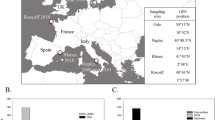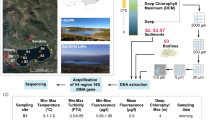Abstract
Recent culture-independent molecular analyses have shown the diversity and ecological importance of microbial eukaryotes (protists) in various marine environments. In the present study we directly extracted DNA from anoxic sediment near active fumaroles on a submarine caldera floor at a depth of 200 m and constructed genetic libraries of PCR-amplified eukaryotic small-subunit (SSU) rDNA. By sequencing cloned SSU rDNA of the libraries and their phylogenetic analyses, it was shown that most sequences have affiliations with known major lineages of eukaryotes (Cercozoa, Alveolata, stramenopiles and Opisthokonta). In particular, some sequences were closely related to those of representatives of eukaryotic parasites, such as Phagomyxa and Cryothecomonas of Cercozoa, Pirsonia of stramenopiles and Ichthyosporea of Opisthokonta, although it is not clear whether the organisms occur in free-living or parasitic forms. In addition, other sequences did not seem to be related to any described eukaryotic lineages suggesting the existence of novel eukaryotes at a high-taxonomic level in the sediment. The community composition of microbial eukaryotes in the sediment we surveyed was different overall from those of other anoxic marine environments previously investigated.







Similar content being viewed by others
References
Amaral Zettler LA, Gómez F, Zettler E, Keenan BG, Amils R, Sogin ML (2002) Eukaryotic diversity in Spain’s River of Fire. Nature 417:137
Aramaki S, Ui T (1966) The Aira and Ata pyroclastic flow and related caldera and depressions in southern Kyushu, Japan. Bull Volcanol 29:29–48
Berney C, Fahrni J, Pawlowski J (2004) How many novel eukaryotic ‘kingdoms’? Pitfalls and limitations of environmental DNA surveys. BMC Biol 2:13
Bulman SR, Kühn SF, Marshall JW, Schnepf E (2001) A phylogenetic analysis of the SSU rRNA from members of the Plasmodiophorida and Phagomyxida. Protist 152:43–51
Cavalier-Smith T, Chao EE (2003) Phylogeny and classification of phylum Cercozoa (Protozoa). Protist 154:341–358
Dawson SC, Pace NR (2002) Novel kingdom-level eukaryotic diversity in anoxic environments. Proc Natl Acad Sci USA 99:8324–8329
Díez B, Pedrós-Alió C, Massana (2001) Study of genetic diversity of eukaryotic picoplankton in different oceanic regions by small-subunit rRNA gene cloning and sequencing. Appl Environ Microbiol 67:2932–2941
Drebes G, Kühn SF, Gmelch A, Schnepf E (1996) Cryothecomonas aestivalis sp. nov., a colourless nanoflagellate feeding on the marine centric diatom Guinardia delicatula (Cleve) Hasle. Helgol Wiss Meeresunters 50:497–515
Edgcomb VP, Kysela DT, Teske A, de Vera Gomez A, Sogin ML (2002) Benthic eukaryotic diversity in the Guaymas Basin hydrothermal vent environment. Proc Natl Acad Sci USA 99:7658–7662
Felsenstein J (1985) Confidence limits on phylogenies: an approach using the bootstrap. Evolution 39:783–791
Hashimoto J, Miura T, Fujikura K, Ossaka J (1993) Discovery of Vestimentiferan tube-worms in the euphotic zone. Zoolog Sci 10:1063–1067
Hugenholtzt P, Huber T (2003) Chimeric 16S rDNA sequences of diverse origin are accumulating in the public databases. Int J Syst Evol Microbiol 53:289–293
Ikemoto E, Kyo M (1993) Development of microbiological compact mud sampler. JAMSTEC Res (In Japanese with English abstract) 30:1–16
Knoll AH (1999) A new molecular window on early life. Science 285:1025–1026
Kühn S, Drebes G, Schnepf E (1996) Five species of the nanoflagellate Pirsonia in the German Bight, North Sea, feeding on planktic diatoms. Helgoländer Meeresunters 50:205–222
López-García P, Rodriguez-Valera F, Pedros-Alio C, Moreira D (2001) Unexpected diversity of small eukaryotes in deep-sea Antarctic plankton. Nature 409:603–607
López-García P, Philippe H, Gail F, Moreira D (2003) Autochthonous eukaryotic diversity in hydrothermal sediment and experimental microcolonizers at the Mid-Atlantic Ridge. Proc Natl Acad Sci USA 100:697–702
Maidak BL, Cole JR, Lilburn TG, Parker CT Jr, Saxman PR, Farris RJ, Garrity GM, Olsen GJ, Schmidt TM, Tiedje JM (2001) The RDP-II (Ribosomal Database Project). Nucleic Acids Res 29:173–174
Massana R, Guillou L, Díez B, Pedrós-Alió C (2002) Unveiling the organisms behind novel eukaryotic ribosomal DNA sequences from the ocean. Appl Environ Microbiol 68:4554–4558
Massana R, Castresana J, Balague V, Guillou L, Romari K, Groisillier A, Valentin K, Pedrós-Alió C (2004) Phylogenetic and ecological analysis of novel marine stramenopiles. Appl Environ Microbiol 70:3528–3534
Matsumoto T (1943) The four gigantic caldera volcanoes of Kyushu. Jpn J Geol Geogr (Special No) 19:1–57
Moon-van der Staay SY, De Wachter R, Vaulot D (2001) Oceanic 18S rDNA sequences from picoplankton reveal unsuspected eukaryotic diversity. Nature 409:607–610
Moreira D, López-García P (2003) Are hydrothermal vents oases for parasitic protists? Trends Parasitol 19:556–558
Naganuma T (1991) Collection of chemosynthetic sulfur bacteria from a hydrothermal vent and submarine volcanic vents. JAMSTEC Deep Sea Res 7:201–219
Oki K, Hayasaka S (1978) Geological study on Kagoshima Bay, South Kyushu, Japan. Part IV - A note on the peculiar mode of occurrence of foraminifers in the bottom sediments of the bay-head area. Rep Fac Sci Kagoshima Univ Earth Sci Biol 11:1–11
Ossaka J, Hirabayashi J, Nogami K, Kurosaki M, Hashimoto J (1992) Variation of chemical composition of volcanic gases from the northern part of Kagoshima bay. JAMSTEC Deep Sea Res (In Japanese with English abstract) 8:75–80
Pawlowski J, Bolivar I, Fahrni JF, de Vargas C, Gouy M, Zaninetti L (1997) Extreme differences in rates of molecular evolution of foraminifera revealed by comparison of ribosomal DNA sequences and the fossil record. Mol Biol Evol 14:498–505
Posada D, Crandall KA (1998) MODELTEST: testing the model of DNA substitution. Bioinformatics 14:817–818
Saitou N, Nei M (1987) The neighbor-joining method: a new method for reconstructing phylogenetic trees. Mol Biol Evol 4:406–425
Schnepf E, Drebes G, Elbrächter M (1990) Pirsonia guinardiae, gen. et spec. nov.: a parasitic flagellate on the marine diatom Guinardia flaccida with an unusual mode of food uptake. Helgoländer Meeresunters 44:275–293
Schweikert M, Schnepf E (1997) Light and electron microspical observations on Pirsonia punctigerae spec. nov., a nanoflagellate feeding on the marine centric diatom Thalassiosira punctigera. Europ J Protistol 33:168–177
Simoneit BRT, Lonsdale PF (1982) Hydrothermal petroleum in mineralized mounds at the seabed of Guayman Basin. Nature 295:198–202
Spero HJ (1987) Symbiosis in the planktonic foraminifer, Orbulina universa, and the isolation of its symbiotic dinoflagellate, Gymnodinium beii sp nov. J Phycol 23:307–317
Stoeck T, Epstein S (2003) Novel eukaryotic lineages inferred from small-subunit rRNA analyses of oxygen-depleted marine environments. Appl Environ Microbiol 69:2657–2663
Stoeck T, Taylor GT, Epstein SS (2003) Novel eukaryotes from the permanently anoxic Cariaco Basin (Caribbean Sea). Appl Environ Microbiol 69:5656–5663
Swofford DL, Waddell PJ, Huelsenbeck JP, Foster PG, Lewis PO, Rogers J (2001) Bias in phylogenetic estimation and its relevance to the choice between parsimony and likelihood methods. Syst Biol 50:525–539
Takahashi T (1981) Seasonal differences of the circulation processes in a coastal basin nearly closed by land. Ocean Manag 6:189–200
Tamura K, Nei M (1993) Estimation of the number of nucleotide substitutions in the control region of mitochondrial DNA in humans and chimpanzees. Mol Biol Evol 10:512–526
Thompson JD, Higgins DG, Gibson TJ (1994) CLUSTAL W: improving the sensitivity of progressive multiple sequence alignment through sequence weighting, position-specific gap penalties and weight matrix choice. Nuc Acids Res 22:4673–4680
Tillmann U, Hesse KJ, Tillmann A (1999) Large-scale parasitic infection of diatoms in the Northfrisian Wad-den Sea. J Sea Res 42:255–261
Yamanaka T, Mizota C, Murae T, Hashimoto J (1999) A current forming petroleum associated with hydrothermal mineralization in a submarine caldera, Kagoshima Bay, Japan. Geochem J 33:355–367
Yamanaka T, Ishibashi J, Hashimoto J (2000) Organic geochemistry of hydrothermal petroleum generated in the submarine Wakamiko caldera, southern Kyushu, Japan. Org Geochem 31:1117–1132
Acknowledgements
We thank Drs. D. Roberts (The Natural History Museum) and J. Reimer (JAMSTEC) for critical reading of the manuscript; Dr. M. Tsuchiya (JAMSTEC) for providing a set of PCR primers specific for the foraminiferan SSU rDNA; Drs. M. Nishijima (NCIMB Japan) and K. Ohki (Kagoshima University) for useful information; the captain and crew of the R/V Natsushima and the commander, pilots and operation team of the ROV Hyper-Dolphin for thier dedicated efforts.
Author information
Authors and Affiliations
Corresponding author
Additional information
Communicated by K. Horikoshi
Rights and permissions
About this article
Cite this article
Takishita, K., Miyake, H., Kawato, M. et al. Genetic diversity of microbial eukaryotes in anoxic sediment around fumaroles on a submarine caldera floor based on the small-subunit rDNA phylogeny. Extremophiles 9, 185–196 (2005). https://doi.org/10.1007/s00792-005-0432-9
Received:
Accepted:
Published:
Issue Date:
DOI: https://doi.org/10.1007/s00792-005-0432-9




